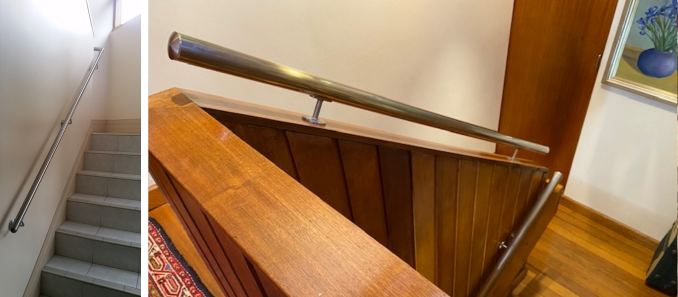How To Attach Handrail Brackets To A Stainless Steel Rail
How To Attach Handrail Brackets To A Stainless Steel Rail
Attaching stainless steel handrail to a wall mounted bracket or top mounted handrail bracket is a simple, DIY friendly task; however admittedly is a little more involved than attaching a timber handrail. This is due to the fact that stainless steel handrails often are not thick enough to use self tapping screws, and attaching them with glue alone is often not a strong enough connection. Over time, the rail is susceptible to coming loose without the correct fixings.
Below, we’ve listed two tried and true methods for attaching stainless steel handrails to brackets!
Related Reading: Everything You Need To Know About Handrail Brackets

Methods for attaching stainless steel handrail to brackets
1. Pop rivets / Blind Rivets
By far the easiest and most common method of attaching stainless steel handrail to handrail brackets would be through the use of pop rivets. This method should work in most circumstances, even when the stainless steel tube has a wall thickness of less than 3mm.
Where possible, we recommend using stainless steel pop rivets over galvanised steel rivets or aluminium rivets, as in some cases using multiple types of steel can cause contamination or corrosion. We’ve covered this in some of our previous articles including “What Kind Of Wire Cable Is Best For Balustrading?”, but to summarise:
Mixing metals can lead to a multitude of issues such as rusting, tea staining and corrosion. This chemical reaction can happen in as little as 2-3 weeks, and cannot be corrected after the fact. If you have noticed tea staining or corrosion on your stainless steel handrail in a very short period of time, this is likely due a chemical process caused by coming into contact with metals such as galvanised steel.
Using pop rivets to attach your handrail to your bracket is extremely straightforward, and only requires the use of two tools: a pop rivet gun and an electric drill. The size of drill hole required will vary depending on the brand and type of pop rivet or blind rivet in use, so make sure to check the directions for your specific rivets.
It’s also important to keep the height/size of your stainless steel tube in mind when purchasing blind rivets. You’ll need to ensure that the height of the rivet does not exceed the height of your handrail.
2. Self tapping screws
If the stainless steel handrail/tube being used has a wall thickness of 3mm or thicker, then self tapping screws can be used in leiu of pop rivets.
Self tapping screws are a kind of metal screw that creates it’s own thread as it is turned (as opposed to threads and screws that require tapping ahead of time). They’re extremely convenient, but need a decent amount of metal/meterial to grab correctly.
We do not recommend using self tapping screws with handrail/stainless steel tube that has a wall thickness less than 3mm, as this connection will loosen with time.

